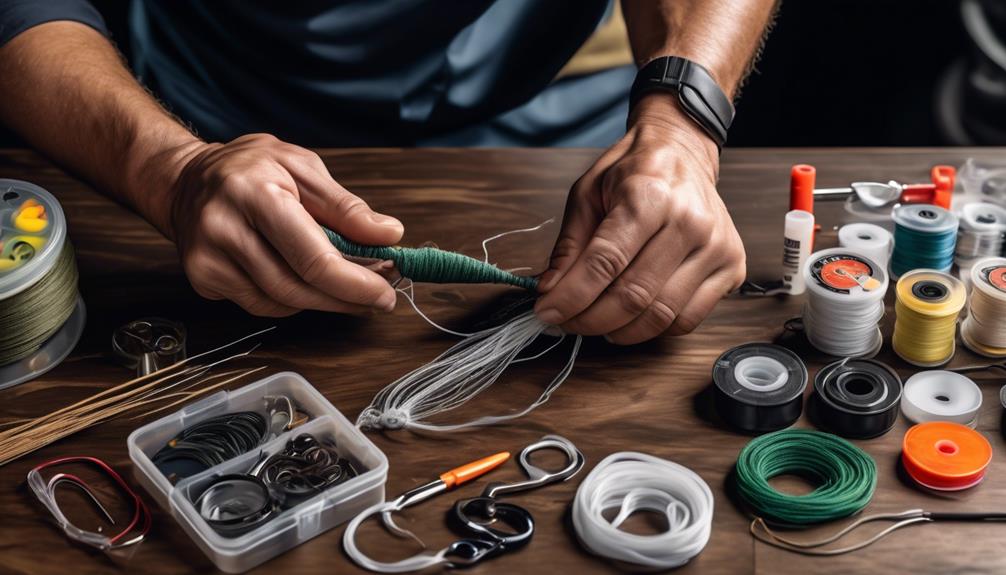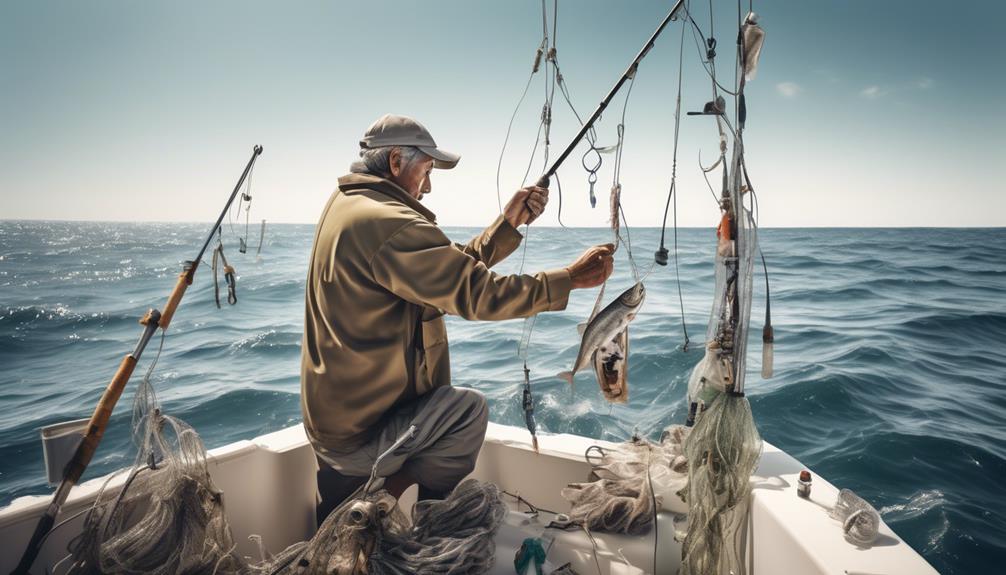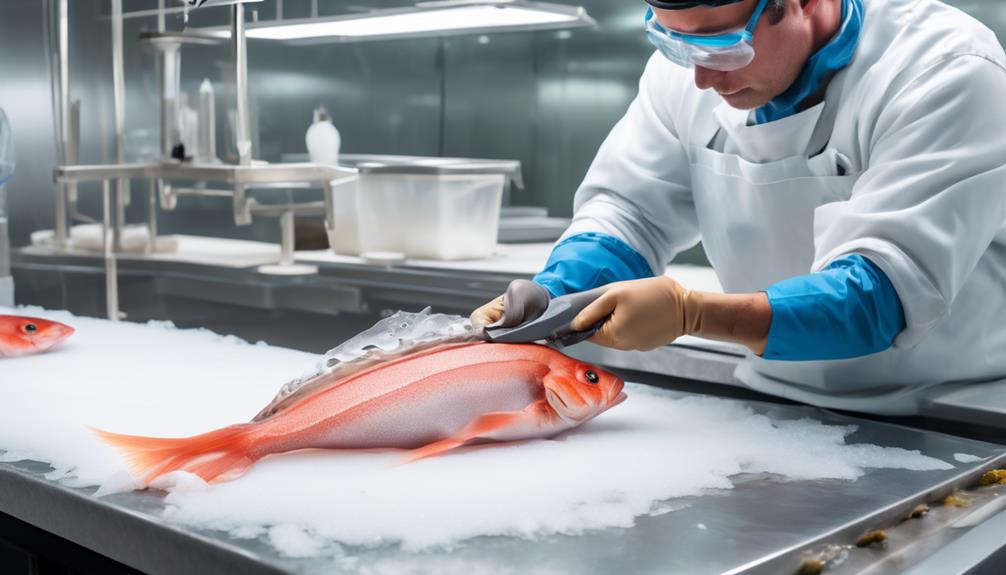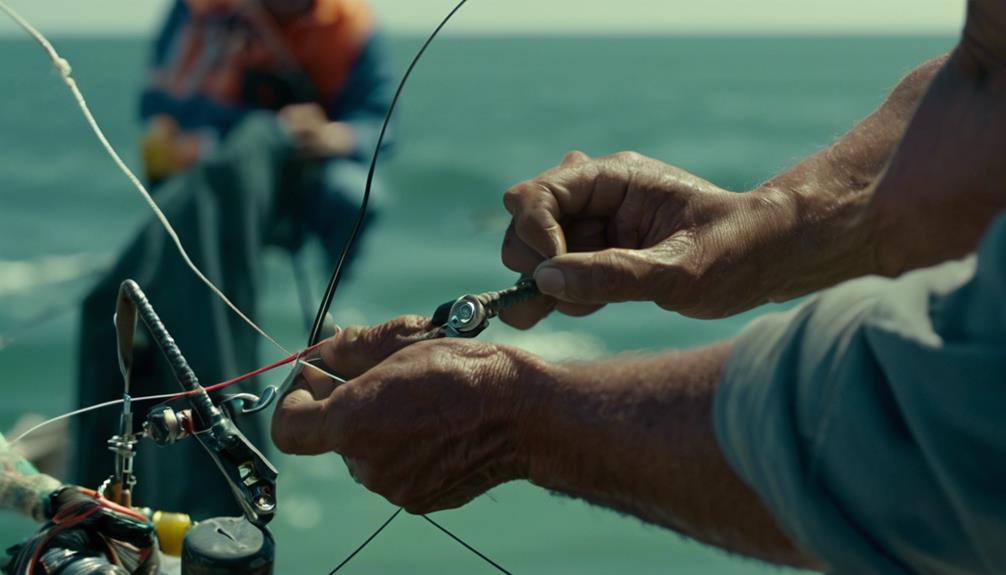When it comes to saltwater fishing rigging, you've probably experienced the frustration of losing a catch due to a poorly set-up rig. Whether you're a seasoned angler or just starting out, mastering the art of effective rigging can make all the difference in your fishing success.
From selecting the right line to tying effective knots, each aspect plays a crucial role in ensuring that your rig is primed for success. So, if you want to improve your chances of landing that prized saltwater catch, it's essential to understand and apply these effective techniques for rigging.
Selecting the Right Line
Have you ever wondered how to choose the right fishing line for saltwater fishing? When it comes to selecting the ideal line for saltwater fishing, two crucial factors to consider are line strength and durability, as well as line visibility and camouflage.
Firstly, let's talk about line strength and durability. Saltwater fish tend to be larger and more powerful than their freshwater counterparts, so your fishing line needs to be able to withstand their strength. Look for lines that have a higher pound test rating, as this indicates greater strength. Additionally, consider the durability of the line, especially in saltwater conditions where corrosion can be a concern. Braided lines are known for their strength and durability, making them a popular choice for saltwater fishing.
Secondly, line visibility and camouflage play a significant role in saltwater fishing. While fishing in clear waters, a highly visible line can spook fish. In such cases, a clear or low-visibility line is preferable. On the other hand, in murky or deep waters, a high-visibility line can be advantageous for detecting bites. Some anglers opt for lines with camouflage patterns to blend in with the ocean environment, making them less detectable to fish.
Choosing the Appropriate Hooks
When selecting the appropriate hooks for saltwater fishing, it's essential to consider the line strength and visibility to ensure the best chances of a successful catch. Hook size plays a crucial role in determining the success of your fishing expedition.
Larger hooks are suitable for bigger baits and larger fish species, while smaller hooks are more appropriate for smaller bait and fish. It's important to match the hook size to the bait type.
For instance, when using live bait such as shrimp or small fish, a smaller hook size like 1/0 or 2/0 would be more suitable. Conversely, when using larger bait like squid or mullet, a hook size of 4/0 or 5/0 might be more effective for targeting bigger game fish.
Additionally, the type of bait you intend to use will also influence the choice of hooks. For soft baits like plastic lures, offset hooks are popular due to their ability to seamlessly penetrate the bait and hook the fish effectively. J-hooks are suitable for natural bait presentations as they allow for a more natural movement of the bait in the water, enticing the fish to strike.
Circle hooks are highly effective when using chunk baits or live bait, as they're designed to hook the fish in the corner of the mouth, reducing the chance of gut-hooking and improving the overall survival rate of released fish.
Setting Up Leaders and Swivels
To effectively set up leaders and swivels for saltwater fishing, start by selecting the appropriate leader material based on the targeted fish species and fishing conditions. Leader length is crucial; for general use, a leader length of 18-36 inches is suitable, but for larger fish or in areas with sharp objects that could fray the line, longer leaders are advisable. Additionally, consider the weight of the leader material, as heavier leaders are better for larger, stronger fish, while lighter leaders are more suited to smaller, less powerful fish.
Swivel maintenance is an often overlooked aspect of saltwater fishing rigging. It's important to regularly check and maintain swivels to ensure they're functioning correctly. Inspect for any signs of corrosion, rust, or damage and replace any compromised swivels immediately. Properly maintained swivels reduce line twist and breakage, enhancing your fishing experience.
When setting up the leader and swivel, ensure a secure connection between the two. A well-tied knot, such as the double uni knot, is recommended for attaching the leader to the swivel. This knot provides strength and reliability, crucial when battling strong saltwater game fish.
Attaching Weights and Sinkers
Consider using a strong knot, such as the improved clinch knot, to securely attach the weight or sinker to your fishing line. When it comes to sinker options, there are various types to choose from, including split shot, egg sinkers, and pyramid sinkers. The choice of sinker depends on the specific conditions and the type of fish you're targeting.
For effective weight placement, it's important to adjust the position of the weight on your line based on the current and tide. In fast-moving currents, placing the weight closer to the hook can help keep your bait in place. On the other hand, in slower currents, having the weight further up the line can provide a more natural presentation to your bait. Experiment with different weight placement techniques to find what works best for the conditions you're fishing in.
Understanding the effectiveness of different sinker options and weight placement techniques is crucial for successful saltwater fishing. By using the right sinker and adjusting the weight placement based on the current and tide, you can improve your chances of attracting and catching fish. Remember to always secure the sinker to your line with a strong knot to prevent it from slipping during casting or while reeling in your catch.
Rigging Bait for Saltwater Species
If targeting saltwater species, properly rigging bait can significantly enhance your chances of landing a successful catch. Bait presentation is crucial when rigging for saltwater fishing. When rigging live bait, it's essential to keep it lively and natural-looking to entice saltwater species. Use a circle hook to rig the live bait through the lips or back, allowing it to swim freely and appear more enticing to predatory fish. For dead bait, such as squid or mullet, rig it securely to the hook to maintain its natural appearance and movement in the water.
When considering lure options, there are various effective choices for saltwater species. Soft plastic lures, such as swimbaits or jerk baits, can be rigged weedless or with weighted hooks for different depths and conditions. This allows for a versatile presentation to mimic the movement of prey. Additionally, using topwater lures like poppers or walk-the-dog style baits can create an enticing surface disturbance, drawing aggressive strikes from saltwater predators.
It's important to consider the specific species you're targeting and adjust your bait presentation and lure options accordingly. Understanding the behavior and feeding patterns of the saltwater species in your area will help you determine the most effective rigging techniques. Experimenting with different bait presentations and lure options can lead to a better understanding of what works best in various saltwater fishing scenarios.
Tying Effective Knots
When rigging bait for saltwater species, ensuring that you tie effective knots is essential for maintaining the integrity of your rig and increasing your chances of successfully landing a catch. To achieve this, consider the following knot tying techniques and factors that contribute to knot strength, tension, and security:
- Knot Tying Techniques:
Utilize the improved clinch knot. This knot is relatively easy to tie and provides strong resistance against the tension produced by powerful saltwater species.
Learn the Palomar knot. This knot is known for its simplicity and ability to maintain a high percentage of the line's original breaking strength.
- Factors that contribute to knot strength, tension, and security:
Choose the right type and diameter of line for your specific fishing application. Thicker lines may require different knot tying techniques compared to thinner lines.
Ensure that the knot is tied properly and tightened securely. A loose or improperly tied knot can significantly decrease its strength and effectiveness.
Consider using a lubricant, such as saliva or line conditioner, to reduce friction and make the knot easier to tie.
Regularly inspect your knots for any signs of wear or damage. Replace any weakened or damaged knots to maintain the strength and security of your rig.
Constructing Effective Rigs

To construct effective rigs for saltwater fishing, start by selecting the appropriate type and strength of leader material based on the target species and fishing conditions. Rigging equipment such as swivels, hooks, and sinkers should be chosen according to the specific fishing techniques and the size of the intended catch. When targeting larger, stronger fish, opt for heavy-duty leaders and hooks. For smaller, more finicky species, lighter leaders and smaller hooks may be more appropriate.
After selecting the right materials, assemble the rig with precision. Tie knots securely, ensuring that all connections are strong and reliable. For example, the improved clinch knot is excellent for securing hooks to the leader, while the Palomar knot is a great choice for attaching the leader to the mainline. Properly crimp any sleeves or swivels to prevent slippage under pressure. When constructing rigs, pay attention to the weight distribution and the placement of attractants or bait to ensure the rig behaves naturally in the water.
As you construct your rig, consider the fishing techniques you'll be using. For example, if you plan to troll for pelagic species, rig outriggers or downriggers to spread lines and keep baits at the desired depth. If bottom fishing for species like grouper or snapper, use a sliding sinker rig to present bait near the ocean floor. Adapting your rigging to specific fishing techniques will increase your chances of success on the water.
Tips for Rigging in Different Conditions
Rigging your tackle to adapt to different conditions is crucial for optimizing your success in saltwater fishing. To ensure you're prepared for varying environments and situations, consider the following tips for rigging in different conditions:
- Tackle Maintenance:
Regularly inspect and clean your tackle to ensure it's in optimal condition. This includes checking for any signs of wear and tear on your lines, leaders, and hooks. Replace any damaged components to prevent equipment failure during crucial moments.
Keep your reels well-lubricated and functioning smoothly. Saltwater can be corrosive, so rinsing your gear with freshwater after each use and properly storing it can help prolong its lifespan.
- Weather Considerations:
Pay attention to the weather forecast before heading out. Wind, tides, and currents can greatly impact your fishing experience. Adjust your rigging strategy based on these factors. For example, in windy conditions, consider using heavier sinkers to keep your bait in place.
Be mindful of the water temperature and how it affects fish behavior. During colder weather, fish may be deeper, so adjust your rigging to reach the appropriate depths.
Frequently Asked Questions
How Can I Effectively Use Live Bait in Saltwater Fishing Rigging?
To effectively use live bait in saltwater fishing rigging, you'll want to focus on using lures and mastering trolling techniques. By incorporating these strategies, you can increase your chances of attracting and catching fish in saltwater environments.
What Are Some Common Mistakes to Avoid When Rigging for Saltwater Fishing?
When rigging for saltwater fishing, avoid common mistakes like not properly handling bait and causing tangles. Keep lines and leaders organized and secure to prevent frustration and lost catches.
Are There Any Specialized Techniques for Rigging in Deep Sea Fishing Scenarios?
When deep sea fishing, specialized techniques can enhance your rigging scenarios. Advanced rigging techniques are crucial for deep sea fishing. These methods optimize your setup for the unique conditions and challenges of deep sea fishing.
How Do I Know When to Use a Loop Knot Versus a Clinch Knot in Saltwater Fishing Rigging?
When rigging in saltwater fishing, use a loop knot for its benefits in allowing your bait to move naturally. If you need a strong and simple alternative, consider using a clinch knot. Experiment and see what works best for you.
What Are Some Advanced Rigging Techniques for Targeting Specific Saltwater Species, Such as Marlin or Tuna?
When targeting specific saltwater species like marlin or tuna, offshore trolling and bait presentation are crucial. Lure selection and fishing techniques play a key role in enticing these elusive fish, so mastering these skills is essential.
Conclusion
Now that you have learned the effective techniques for saltwater fishing rigging, you can head out onto the water with confidence.
Remember to:
- Select the right line
- Choose appropriate hooks
- Set up leaders and swivels
- Attach weights and sinkers
- Rig bait for saltwater species
- Tie effective knots
- Construct effective rigs.
With these tips and tricks, you'll be ready to catch some impressive saltwater fish in any conditions.
Happy fishing!



